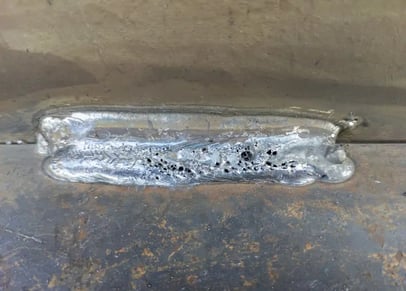Untangling the Enigma of Porosity in Welding: Tips for Reducing Defects and Maximizing Quality
In the detailed world of welding, porosity continues to be a persistent difficulty that can substantially impact the high quality and honesty of bonded joints. Understanding the elements that add to porosity development is important in the pursuit of flawless welds. By unraveling the enigma of porosity and applying effective methods for problem reduction, welders can elevate the standards of their work to accomplish premium high quality outcomes. As we explore the depths of porosity in welding, uncovering the tricks to its prevention and control will certainly be extremely important for professionals seeking to grasp the art of premium weldments.
Recognizing Porosity in Welding
Porosity in welding, an usual concern experienced by welders, refers to the presence of gas pockets or spaces in the bonded product, which can compromise the integrity and quality of the weld. These gas pockets are usually entraped throughout the welding procedure because of various elements such as inappropriate shielding gas, infected base products, or incorrect welding criteria. The development of porosity can compromise the weld, making it at risk to splitting and corrosion, eventually leading to architectural failings.
By acknowledging the relevance of preserving proper gas shielding, making certain the cleanliness of base products, and maximizing welding settings, welders can considerably reduce the chance of porosity formation. In general, a detailed understanding of porosity in welding is necessary for welders to create high-grade and resilient welds.

Usual Causes of Porosity
When inspecting welding processes for possible high quality problems, recognizing the usual causes of porosity is vital for keeping weld honesty and avoiding architectural failures. Porosity, characterized by the visibility of cavities or gaps in the weld steel, can considerably endanger the mechanical residential or commercial properties of a bonded joint.
An additional prevalent source of porosity is the existence of moisture and contaminants externally of the base metal or filler product. When welding products are not effectively cleansed or are subjected to high levels of moisture, the vaporization of these pollutants during welding can produce gaps within the weld bead. Additionally, welding at incorrect parameters, such as excessively high traveling speeds or currents, can create excessive turbulence in the weld swimming pool, trapping gases and creating porosity. By dealing with these usual causes with correct gas protecting, product preparation, and adherence to optimal welding criteria, welders can lessen porosity and improve the high quality of their welds.
Methods for Porosity Avoidance
Carrying out efficient preventative procedures is critical in minimizing the event of porosity in welding processes. One technique for porosity avoidance is guaranteeing proper cleansing of the base steel before welding. Pollutants such as oil, grease, corrosion, and paint can result in porosity, so detailed cleaning making use of ideal solvents or mechanical methods is essential.

Another secret precautionary action is the option of the best welding consumables. Using high-grade filler products and shielding gases that appropriate visit their website for the base steel and welding procedure can significantly minimize the danger of porosity. Additionally, preserving proper welding criteria, such as voltage, current, travel rate, and gas circulation price, is essential for porosity prevention. Differing the recommended setups can cause inappropriate gas insurance coverage and insufficient combination, leading to porosity.
Furthermore, using proper welding strategies, such as keeping a constant traveling speed, electrode angle, and arc length, can help prevent porosity (What is Porosity). Ample training of welders to guarantee they adhere to best techniques and my response quality assurance treatments is additionally necessary in reducing porosity defects in welding

Finest Practices for High Quality Welds
One secret technique is preserving correct cleanliness in the welding location. Extensively cleaning up the work surface and surrounding area before welding can assist reduce these issues.
One more ideal practice is to meticulously select the proper welding parameters for the specific products being joined. Proper criterion choice guarantees ideal weld infiltration, fusion, and general quality. Utilizing top notch welding consumables, such as electrodes and filler steels, can significantly influence the final weld top quality.
Importance of Porosity Control
Porosity control plays an essential duty in guaranteeing the stability and high quality of welding joints. Porosity, identified by the presence of cavities or voids within the weld metal, can dramatically jeopardize the mechanical homes and architectural integrity of the weld. Extreme porosity weakens the weld, making it a lot more at risk to fracturing, corrosion, and total failing under functional lots.
Efficient porosity control is vital for preserving the desired mechanical homes, such as strength, ductility, and durability, of the bonded joint. What is Porosity. By lessening porosity, welders can enhance the total quality and integrity of the weld, guaranteeing that it fulfills the performance demands of the designated application
Additionally, porosity control is important for attaining the desired aesthetic look of the weld. Excessive porosity not only deteriorates the weld yet also detracts from its visual allure, which can be important in industries where aesthetic appeals are necessary. Correct porosity control strategies, such as using the appropriate protecting gas, managing the welding parameters, and Find Out More making certain proper tidiness of the base materials, are necessary for creating top notch welds with marginal issues.

Verdict
To conclude, porosity in welding is an usual defect that can compromise the top quality of the weld. By understanding the sources of porosity and carrying out appropriate avoidance strategies, welders can minimize flaws and accomplish better welds. It is necessary to control porosity in welding to ensure the honesty and strength of the end product. Carrying out ideal practices for porosity control is important for achieving ideal welding outcomes.